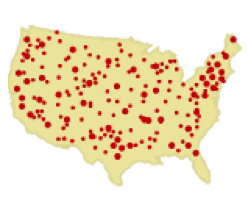 According to their website: “Green Dot, etc. is an organization built on the premise that we can measurably and systematically reduce violence within any given community. We believe current research across disciplines, in combination with lessons learned from history, provides nearly all of the necessary puzzle pieces to create a successful model of violence prevention. Given this foundation of knowledge, we believe any group, committed to equipping themselves with the necessary skills and willing to let go of historically ineffective approaches, has the capacity to implement a successful violence prevention strategy.”
According to their website: “Green Dot, etc. is an organization built on the premise that we can measurably and systematically reduce violence within any given community. We believe current research across disciplines, in combination with lessons learned from history, provides nearly all of the necessary puzzle pieces to create a successful model of violence prevention. Given this foundation of knowledge, we believe any group, committed to equipping themselves with the necessary skills and willing to let go of historically ineffective approaches, has the capacity to implement a successful violence prevention strategy.”
For more information: https://www.livethegreendot.com/
Green Dot TCNJ
Visualize for a moment unforgettable images of small red dots spreading across a computer-generated map of the US, symbolizing the spread of some terrible epidemic – with each tiny red dot representing an individual case. With disturbing speed, the three or four single dots multiply and spread until the whole map emits a red glow comprised of a zillion tiny dots.
Now Imagine A Map On TCNJ’s Campus:
Each red dot on this map represents an act of power-based personal violence (partner violence, sexual violence, or stalking) – or a choice to tolerate, justify or perpetuate this violence. A red dot is a rape – a red dot is a hit – a red dot is a threat – a red dot is a statement that justifies or minimizes violence – a red dot is an individual choice to do nothing in the face of a high-risk situation. Power-based personal violence is not a huge, solid mass that can simply be removed with one swift action or policy. Rather, it is the accumulation of individual decisions, moments, values, and actions made by men and women from every corner of our campus. It’s hard to know exactly how many red dots are on our map at any given moment – but we do know there have been enough red dots to create a culture that sustains far too many women and men experiencing violence.
Now Imagine Adding A Green Dot In The Middle Of All Those Red Dots:
Imagine that a green dot is any behavior, choice, word, or attitude that promotes safety for all of us and communicates utter intolerance for any form of violence. A green dot is pulling a friend out of a high risk situation – a green dot is putting a green dot statement on our Facebook page – a green dot is doing a paper about violence prevention – a green dot is hanging an awareness poster in your hall or classroom – a green dot is wearing your green dot gear – a green dot is encouraging discussion in class about violence prevention – a green dot is striking up a conversation with a friend about how much this issue matters to you – a green dot is organizing a fundraiser for campus prevention efforts – a green dot is getting your organization to go to green dot bystander training. A green dot is simply your individual choice at any given moment to make our campus safer.
Bystander Intervention Tips
There are many prevention methods that students, staff and faculty can utilize to address concerns of sexual violence and relationship violence. One of the most widely used and publicized strategies of intervening is called “bystander intervention”. Bystander intervention is a primary prevention tool that allows for something to be prevented before it has the possibility of happening. An active bystander is someone who finds a way to safely intervene to stop a potentially dangerous situation. For example, asking a friend who is very intoxicated if you can walk them home as they are going upstairs with someone that met that night at a party.
The Three D’s of Bystander Intervention
Intervening isn’t always easy, and we encourage everyone to keep their personal safety a priority when evaluating a situation that could benefit from intervention. At The College, we employ three different intervention strategies that can be tailored to specific situations and the comfort level of the active bystander. Students, faculty and staff can intervene in potentially harmful situations using one of the three Ds:
- Direct: You could be direct, and walk over to the person who slipped something into another person’s drink and say, “I saw what you did. I’m going to call the police.” Or, you could say something directly to the potential victim and let them know what you saw.
- Distract: One of our other options is to distract one of the people involved in that scenario.You could go up to one of them and say, “Hassan’s here with pizza.” Or, if it’s a friend, you “need them to come to the bathroom with you.”
- Delegate: Another option is to delegate out some of the responsibility. Sometimes in these situations, we need to call in reinforcements. If you’re feeling you need extra support, call on your friends. Or, in our party scenario, you can let the host know what’s happening. In other situations around campus, you could call your CA.
The Office of Anti-Violence Initiatives has many ways to get involved and be part of the culture shift to create awareness around power-based violence issues and to be a positive, active bystander.
For more information on how to be a Peer Education Member: https://oavi.tcnj.edu/save/
For more information on how to be a Volunteer or Intern: https://oavi.tcnj.edu/volunteers/
